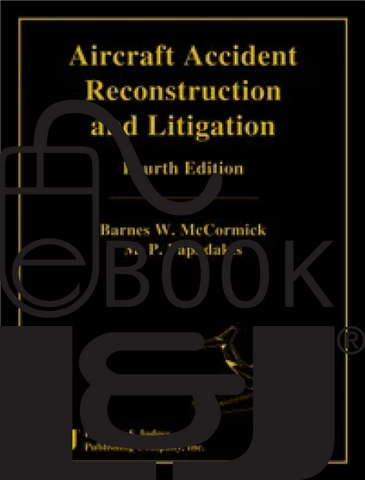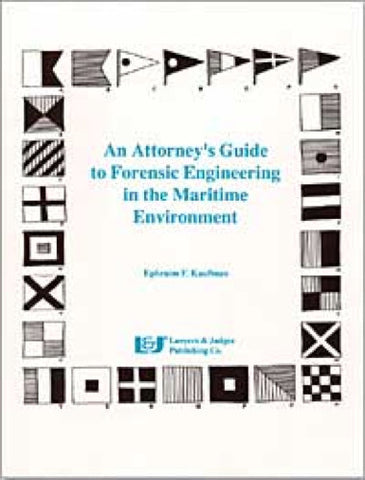
Packaging Forensics
- Author: Walter Stern; Contributors: Robert J. Bockserman, Martin K. Brigham, G.E. Campbell, Patrick E. Carr, Charles R. Goerth, Peter Henningsen, Jr., Matthew W. Loughren, Robert A. Luciano, Alfred H. McKinley, Francis Patrick Murphy, George A. Peters, Grantges J. Raymus, Barry S. Rope, Jack L. Rosette, Paul Singh, Suzelle M. Smith, Eunice Trevor, Nancy A. Zettler,
- ISBN 10: 0-913875-78-3
- ISBN 13: 978-0-913875-78-0
- Copyright Date Ed: December 13, 2000
- Pages: 352 pages
- Binding Information: Hardcover
- Size: 6 ✕ 9 Inches (US)
An in-depth reference for the products liability litigator.
With the many variables to consider in any packaging forensics case, you'll first need to determine what type of expert to hire. A safety specialist? A mechanical engineer? Or an accident reconstructionist?
Written by veteran packaging engineers and attorneys, you'll find that you'll have all the information you need to successfully litigate your case. Packaging forensics is a unique specialty incorporating transportation, distribution, packaging, and materials handling. You'll learn how the proper documentation and photographic evidence of a manufacturer's operations in storage, loading, and ensuring the security of packages will convince the defense settle a case before it goes to trial. Was weight distribution a factor in the accident? Were industry standards followed? Were written safety instructions read prior to the accident? \Whether you're an attorney working for the defense or plaintiff, an industry executive or active professional engineer, you'll find that this book will be a most useful resource on this complex area of expertise.
This book is also available as an eBook. Click here to purchase and download:
TOPICS COVERED
- The packaging expert in litigation
- Transport packaging for glass table tops
- Packaging your case for success
- The trend toward lessening the product liability burden on industry
- The role of the expert witness in hazardous materials litigation
- Packaging machinery litigation cases
- Single parcel shipments by ground and air carriers
- Using packaging experts at trial in the post
- Daubert era
- Case of refused payment for product delivery because of supposed shipment damage
Table of Contents
Chapter 1: Introduction
1.1 What Is Packaging Forensics?
1.2 How to Locate and Retain a Packaging Expert
1.3 How to Work with Your Expert
1.4 The Expert's Financial Arrangements
1.5 Saying "Goodbye" to Your Expert
1.6 How This Book Is Organized
Chapter 2: Package Failure in the Courts
Walter Stern
2.1 Introduction
2.2 Typical Package-Failure Cases
A. Glass bottles
B. Closures
C. Labeling
D. Dispensing
E. Multiwall bags
F. Caution notices
G. Set-up boxes
H. Stapling
I. Plastic bottles
J. Multipacks
K. Corrugated cases
2.3 Ways to Minimize the Risk of Lawsuits
A. Make packages user-friendly
B. Design holding ease, use
C. Test full distribution cycles
D. Preserve your QC records
E. Use independent tests
F. Consult a forensic expert
Chapter 3: The Packaging Expert
Walter Stern
Chapter 4: Packaging and Product Liability
Nancy A. Zettler, Esq.
4.1 The Trend Toward Lessening the Product Liability Burden on Industry
A. The trend as it affects packaging
B. Warnings
4.2 The State of Product Liability Law in the U.S. Today
A. Safety packaging
B. The Tylenol litigation
C. Foreseeability
D. Proving foreseeability
E. Prior notice of similar misuse
F. Feasibility of alternative packaging
4.3 Avoiding Litigation
A. The manufacturer as expert
B. Reliance on industry standards
4.4 Conclusion
References
Chapter 5: Using Packaging Experts at Trial in the Post-Daubert Era
Suzelle M. Smith, Esq.
5.1 Introduction
5.2 Infant versus Distributor of Apple Juice
5.3 Defendant's Packaging Expert and His Impressive Defense of the Product
5.4 Plaintiff Retains an Expert
5.5 Defendants Make a Daubert Motion to Preclude Plaintiffs' Expert and Have
the Court Thereafter Enter Summary Judgment
A. Defendants request a Daubert evidentiary hearing
B. Procedure
C. Defendant's objections
D. Plaintiffs response
E. Hearing
F. Ruling
5.6 Case Resolution
Chapter 6: Product Hazard Communications
Charles R. Goerth, Esq. and George A. Peters, Esq., P.E.
6.1 Introduction
6.2 Space and Location
6.3 Space Expansion
6.4 Basic Criteria
6.5 Conclusion
Chapter 7: Ocular Injuries Caused by Institutional Food Packaging
Robert J. Bockserman, C.P.P.
7.1 Background
7.2 The Petition: (Key Paragraphs)
7.3 One of the Defendant's answers (Among Many) to the Petition
7.4 Technical Background of Product Information for the Basis of Expert Testimony
for the Case
7.5 Deposition Data
7.6 Searching Technical Literature
7.7 Defendant's Motion for Partial Summary Judgment
7.8 The Order of the Court on Whether a Partial Summary Judgment Was to be Granted
7.9 My Conclusions to This Case
References
Chapter 8: Blackburn v. Kitchen Chemical
G.E. Campbell
8.1 Background and Case
8.2 Plaintiff's Claim
8.3 Plastic Containers
8.4 Testing and Inspection
8.5 Conclusion
8.6 Discussion
Chapter 9: George v. MasterLab
G.E. Campbell
9.1 Background and Case
9.2 Plaintiff's Claim
9.3 Plastic Container
9.4 Testing and Inspection
9.5 Conclusion
9.6 Discussion
Chapter 10: The Case of the Careless Nurse: $10 million verdict for wrongful death of a 91-year-old woman from an overdose of Lidocaine
ATLA Law Reporter
10.1 The Case of the Careless Nurse
10.2 The Inspiration
10.3 Astra's Answer
10.4 Settlement Talks
10.5 The Trial
10.6 Aggravated Circumstances
10.7 The Verdict: A Voice That Will Be Heard
Chapter 11: When in Doubt, Blame the Box!
Jack L. Rosette, Ph.D., C.C.P.
11.1 Introduction
11.2 Complaint from Client
11.3 History of Complaint
11.4 Components of Packages
11.5 Actual versus Potential Losses
11.6 Background of ECT versus Mullen
11.7 Factors that Contribute to Stacking Strength
11.8 Determining Requirements versus Specification
11.9 Results of Package Analysis
11.10 Examination of Customer Sites
11.11 Identification of Contributing Factors
11.12 History of Problems in the Corrugated Industry
11.13 Contributory Negligence
11.14 Tall Box's Response
11.15 Miles' Response
11.16 Corrective Action
11.17 Possible Additional Remedies
11.18 Advice to Purchasers of Packaging Materials
11.19 Settlement of Case
11.20 Summary
11.21 Epilogue
Chapter 12: The Case of the Burning Man
Walter Stern
Chapter 13: The Case of the Deadly Corrugated Carton
Walter Stern
13.1 Background
13.2 What Happened
13.3 The Investigation
Chapter 14: Packaging Your Case for Success
Martin K. Brigham, Esq. and Eunice Trevor, Esq.
14.1 Introduction
14.2 Prompt Investigation
14.3 Analyzing Potential Liability
A. Identifying literature and resources
B. Identifying expert witnesses
14.4 Proving Liability
14.5 Defenses
A. Compliance with government regulations and industry standards
B. Federal preemption
C. Cost of remedial measures
1. Frequency and severity of accidents
2. Cost of safe packaging
14.6 Conclusion
Chapter 15: The Case of the Dangerous Drain Master
Walter Stern
Chapter 16: A Shattered Bottle . . . a Shattered Life
Francis Patrick Murphy, Esq.
16.1 Introduction
16.2 Investigation
16.3 Complaint at Law
16.4 Discovery
16.5 Expert Evidence: The Expert
16.6 The Dailey Case
16.7 Deposition
16.8 Negotiations
16.9 Conclusion
Chapter 17: The Case of the Stress Cracked Plastic Bottles: "B" v. "C" Company
G.E. Campbell
17.1 Background and Case
17.2 Plaintiff's Claim
17.3 Plastic Containers
17.4 Testing and Inspection
17.5 Conclusion
17.6 Discussion
Chapter 18: Santos v. Automotive Chemical
G.E. Campbell
18.1 Background and Case
18.2 Plaintiff's Claim
18.3 Plastic Container
18.4 Testing and Inspection
18.5 Conclusion
18.6 Discussion
Chapter 19: The Spray Paint Can That Burned Down a House
Walter Stern
Chapter 20: The Packaging Expert in Litigation
Patrick E. Carr
Chapter 21
The Case of the Torn Beverage Carrier
Walter Stern
21.1 Introduction
21.2 The Accident
21.3 General Comments on Beverage Carriers for Soft Drinks
21.4 Examination of the Bottle Carrier in Suit
21.5 Conclusions
Chapter 22: A Billion Dollar Quality Control Problem
Walter Stern
Chapter 23: Distribution Packaging
Barry S. Rope
23.1 Case 1: Pallets of Commercial Bags
23.2 Case 2: Construction Windows
23.3 Case 3: Palletized Sheet Steel
23.4 Case 4: Bags of Industrial Powder
Chapter 24: Single Parcel Shipments by Ground and Air Carriers
Paul Singh, Ph.D.
24.1 Introduction
24.2 Parcel Shipping Environment
A. Shipping orientation and drop heights
B. Use of fragile and pictorial labels
C. Use of shock-sensitive labels
24.3 Role of Pre-Shipment Testing
24.4 Package Functions
24.5 Distribution Packaging Test Methods for Parcel Shipments
24.6 Pictorial Markings
24.7 Precautionary Labeling
24.8 Conclusions
References
Chapter 25: Transport Packaging for Glass Table Tops
Alfred H. McKinley, P.E.
25.1 Overview of the case
A. Summary of events leading to litigation
B. Expert witness retained
25.2 The investigation
A. Initial information
B. Packaging regulations
C. National Motor freight Classification
D. Photos and freight bills
E. Expert's conclusions
25.3 Interrogatories to the Expert
25.4 The Expert's Deposition
25.5 Conclusion of the Case
25.6 Observations Concerning the Case
Chapter 26: Case of Refused Payment for Product Delivery Because of Supposed Shipment Damage
Peter Henningsen, Jr.
26.1 Introduction
26.2 Selecting Expert Witnesses
26.3 Case in Description
26.4 Initial Meeting with Law Firm Principal
A. Establishing confidence between expert witness and attorneys
B. Definition of actions to be taken
26.5 Investigation Procedures
A. Product characteristics and packaging requirements
B. Handling requirements for bagged product
C. Pallets and palletizing considerations
D. Observation of defendant's pallet receiving and handling operations
E. On-site observation of plaintiff's packaging operations
26.6 Data Collection Requirements
A. Identifying needed records
B. Review of plaintiff's production and shipment records
C. Review of defendant's purchase records
26.7 Submission of reports
26.8 Conclusions
Chapter 27: The Case of the Blinding Staples
Walter Stern
Chapter 28: The Role of the Expert Witness in Hazardous Materials Packaging Litigation
Grantges J. Raymus, M.E., M.S., P.E.
28.1 Qualifications
28.2 Serving the Needs of a Trial Attorney
28.3 Serving the Needs of the Court
28.4 Some Typical Cases
A. Personal injury resulted from use of a hazardous material although package
used complied with DOT regulations.
B. A wrong plastic gasket in a steel drum resulted in the spill of a regulated solvent
C. Plaintiff was injured by a flash fire while a solvent was being used by another
workman.
D. An improperly made can resulted in considerable loss of a new product to a major
manufacturer of consumer goods.
28.5 Conclusion
Chapter 29: Packaging Machinery Litigation Cases
Robert A. Luciano, P.E., C.P.P.
29.1 Machine-Related Operator Inquiry
29.2 Description of the Case
29.3 Initial Attorney/Expert Contact
29.4 Inspection of the Accident Scene and the Equipment Involved
29.5 Final Report
Chapter 30: The Case of the Defectively Packaged Pie Server
Matthew W. Loughren, Esq.
30.1 Accident Facts
30.2 The Product
30.3 General Theories of Liability
30.4 Expert Witnesses
30.5 Conclusion
Chapter 31: The Case of the Exploding Bottle Cap
Walter Stern
About the Authors
Index




